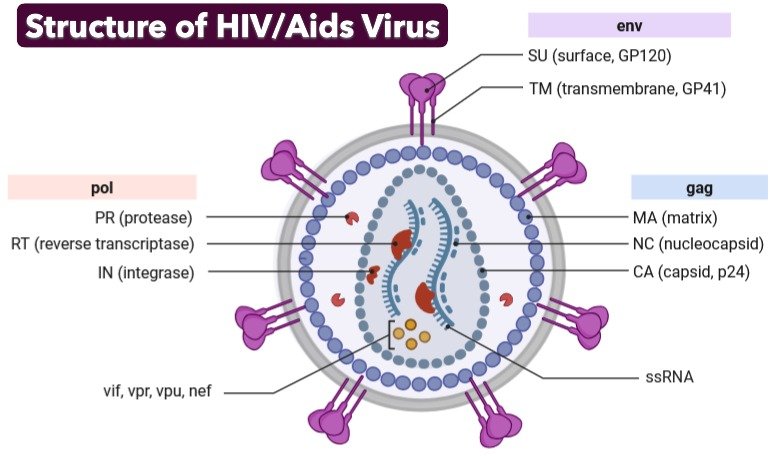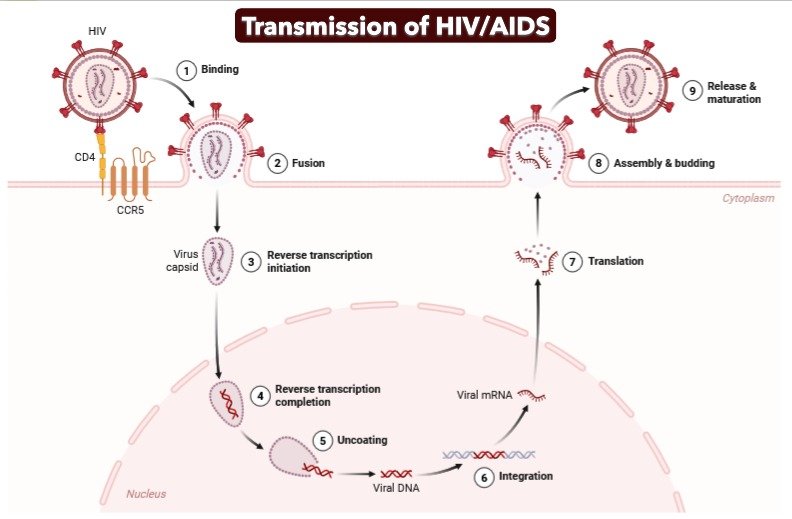Table of Contents
ToggleIntroduction to HIV and AIDS
HIV (Human Immunodeficiency Virus) and AIDS (Acquired Immunodeficiency Syndrome) remain among the most significant global health challenges. Despite major advancements in medical science, HIV continues to affect millions of people worldwide. Understanding the biology of the virus, how it spreads, its symptoms, and methods of prevention is critical for both awareness and control.
This article provides a comprehensive guide to HIV and AIDS — covering structure, symptoms, transmission, diagnosis, and preventive measures — written in a simple yet detailed manner for students, professionals, and the general public.
What is HIV?
HIV stands for Human Immunodeficiency Virus. It is a retrovirus that specifically attacks the immune system, particularly CD4 T-cells (a type of white blood cell). Over time, HIV weakens the immune defense, making individuals more vulnerable to infections and certain cancers.
Key points about HIV:
- It integrates its genetic material into the host DNA using reverse transcriptase.
- Without treatment, HIV gradually reduces immune strength.
- It can lead to the final stage of infection called AIDS.
What is AIDS?
AIDS (Acquired Immunodeficiency Syndrome) is the last and most severe phase of HIV infection. Not everyone with HIV develops AIDS — especially today with effective treatment (ART). However, untreated HIV infection usually progresses to AIDS within 8–10 years.
Characteristics of AIDS:
- Extremely weakened immune system.
- Very low CD4 T-cell counts (below 200 cells/µL).
- Presence of opportunistic infections (such as tuberculosis, candidiasis, or pneumonia) and cancers (like Kaposi’s sarcoma).
Difference Between HIV and AIDS
| Feature | HIV | AIDS |
| Definition | A virus that attacks the immune system | The final stage of HIV infection |
| Cause | Infection by retrovirus HIV-1 or HIV-2 | Progression of untreated HIV |
| Possibility | One can live with HIV without AIDS | Cannot have AIDS without HIV |
| Treatment impact | ART can control HIV and prevent AIDS | ART helps manage AIDS but damage is advanced |
In summary: HIV is the virus; AIDS is the condition it can cause.
Structure of HIV
- Two copies of a single-stranded RNA genome are found inside the conical capsid of HIV1 virions.
- The plasma membrane of the host cell origin, which contains viral envelope proteins, surrounds the capsid.
- The viral particles are about 120 nm in diameter, and the RNA genome has 9750 nucleotides.
- Cryo-electron microscopy tomography has recently revealed a thorough three-dimensional structure of HIV1 envelope glycoprotein spikes, which are necessary for infecting host cells.
- The nucleocapsid proteins p6 and p7, which shield the HIV1 RNA from nuclease digestion, bind to it very securely.
- In addition to reverse transcriptase, integrase, and protease, this viral core also includes protease, integrase, and reverse transcriptase.
- The whole structure is enclosed by an icosahedral capsid (p24), which is surrounded by a myristoylated matrix protein (p17).
- The virion particle also includes the proteins Vif, Vpr, and Nef. As the capsid buds from the host cell, it absorbs some of the host cell membrane to create the envelope.

Symptoms of HIV Infection
Within 2–4 weeks after contracting HIV (early/acute HIV infection), some individuals may have flu-like symptoms such as fever, chills, etc. The duration of these symptoms can range from days to weeks.
1. Acute HIV Infection (2–4 weeks after exposure)
- Flu-like symptoms: fever, chills, sore throat, swollen lymph nodes.
- Skin rash and mouth ulcers.
- Headache, fatigue, muscle pain.
- These symptoms last days to weeks but may be absent in some cases.
2. Chronic HIV Infection (Clinical latency)
- The virus continues to replicate at low levels.
- Many individuals feel healthy for years.
- Without treatment, CD4 counts gradually fall.
3. Progression to AIDS
- Severe weight loss, prolonged fever, and night sweats.
- Recurring infections (TB, pneumonia, fungal infections).
- Neurological symptoms and cancers.
- Life expectancy is drastically reduced without ART.
Transmission of HIV/AIDS
HIV/AIDS can transmitted by:
- Sexual contact with an infected partner is the most common way that HIV is transmitted through sexual contact.
- During sexual activity, the virus penetrates the body through the skin of the vagina, vulva, penis, rectum, or mouth.
- HIV infection caused by blood contamination can also spread through contact with contaminated blood.
- However, the risk of contracting HIV from blood transfusions is very low because blood is screened for indications of HIV infection.
- Sharing needles, syringes, or drug usage gear with someone who has the virus is a common way for HIV to spread through needles.
- The likelihood of transmission between a patient and a healthcare professional, or vice versa, via unintentional sticks with soiled needles or other medical equipment is low.
- Infants born to or nursed by mothers with HIV can also contract the virus through their mothers.

HIV/AIDS Can’t transmitted by:
- Saliva
- Sweat
- Tears
- Sharing items like food utensils, towels, and bedding during casual encounters
- Swimming pools
- Telephones
- The seats on the toilet
- Insects that bite, like mosquitoes
Diagnosis of HIV
Antibody-Antigen Test
- Blood is used from a vein.
- Within two to six weeks following exposure, it identifies antigens (HIV components).
- Months to weeks after, it identifies antibodies that are produced by the immune system.
Antibody Test
- It employs saliva or blood.
- Antibody tests are the majority of quick tests and self-tests.
- After exposure, positivity develops in 3 to 12 weeks.
Nucleic Acid Test (NAT)
- Identifies the virus’s presence (viral load).
- The first test that came back positive after being exposed.
- Recommended if exposure occurred during the last several weeks.
CD4 T Cell Count
- CD4 cells are killed by HIV.
- CD4 count is less than 200, even if there are no signs of AIDS.
Viral Load (HIV RNA Test)
- Determines the amount of virus in the blood.
- treatment aim: an undetectable viral load.
Drug Resistance Test
- Determine if the HIV strain is resistant to particular drugs.
- Assists physicians in selecting the appropriate course of treatment.
Prevention of HIV and AIDS
- Safe sex: Consistently using condoms properly when engaging in vaginal, anal, or oral sex significantly lowers the chance of HIV transmission. The risk is also reduced by having fewer sexual partners.
- Sharing needles is not allowed: It is prohibited to share needles since infected needles or syringes can transmit HIV. Sharing needles, syringes, or other injection gear is never acceptable for those who use drugs.
- PEP and PrEP: Post-exposure prophylaxis (PEP) is an emergency medication that should be administered within 72 hours of potential HIV exposure. Pre-exposure prophylaxis (PrEP) is a daily course of treatment. a preventative tablet for those who are at high risk of contracting HIV, in order to lower their risk of infection.
- Blood: Before using donated blood for transfusions, it should be tested for HIV and other illnesses in order to avoid transmission.
- Prevention from mother to child: To avoid transmitting HIV to their unborn child during pregnancy, delivery, or nursing, pregnant women with HIV can use antiretroviral therapy (ART).
- Early testing and ART: Early testing and ART Early testing aids in initiating therapy on time. ART (antiretroviral therapy) lowers the amount of virus in the body, which helps individuals lead healthy lives and avoid infecting others.
- Circumcision of the male: Male circumcision reduces the chance of heterosexual men contracting HIV, particularly in locations with a high prevalence of the virus.
- Treat sexually transmitted infections (STIs): Treat sexually transmitted diseases (STIs) because they raise the risk of HIV transmission if left untreated. This risk is reduced by routine screening and treatment.
- Use sterile medical instruments: Use sterilized medical equipment. To prevent the spread of HIV and other infections, medical and dental instruments must be properly sterilized.
- Raising knowledge and awareness: Public education regarding HIV transmission and prevention gives individuals the ability to safeguard themselves and others.
- Decrease stigma: By lessening prejudice against those who have HIV, more people are encouraged to get tested and treated without worry.
- Either abstinence or mutual monogamy: Abstaining from sex or being in a relationship with an HIV-negative partner are both good strategies for HIV prevention.
Frequently Asked Questions on HIV/AIDS
Q1. Can HIV be cured?
Currently, no. ART controls the virus, but lifelong treatment is required.
Q2. How long can someone live with HIV?
With treatment, life expectancy is close to normal. Without treatment, progression to AIDS usually occurs within 8–10 years.
Q3. Can HIV be transmitted through kissing?
No. Saliva does not transmit HIV.
Q4. What is “undetectable = untransmittable” (U=U)?
People on ART with undetectable viral load cannot sexually transmit HIV.
Q5. What is the difference between HIV-1 and HIV-2?
HIV-1 is the most common worldwide; HIV-2 is less common and mainly found in West Africa.
Conclusion
HIV and AIDS continue to be major public health challenges, but with proper prevention, early diagnosis, and effective treatment, individuals can lead long and healthy lives. Education, awareness, and reducing stigma are key weapons in the fight against HIV.
By following preventive measures such as safe sex, needle safety, ART, and PrEP, we can move closer to an AIDS-free future.
Also Read
- Single Cell Protein (SCP): Sources, Production, Advantages, Disadvantages & Applications
- Detection of Viruses: Modern Methods, Applications, and Advancements
- Molecular Blotting: Techniques, Uses, and Significance
- Mycorrhiza: Structure, Types, and Role in Plant Growth
- Rhizobium: The Nitrogen-Fixing Bacterium
- Microbiology: From Microorganisms to Career Opportunities
- Biochar: Properties, Production, and Applications
- Immune System Cells: The Body’s Cellular Defenders
- Top 10 Universities in India for Microbiology
- Basics of Food Microbiology in
- Microbiology Notes
- Medical Microbiology Quiz
- Basic Microbiology Quiz
Reference and Sources
- https://my.clevelandclinic.org/health/diseases/4251-hiv-aids
- https://www.ncbi.nlm.nih.gov/books/NBK304351/
- https://hivinfo.nih.gov/understanding-hiv/fact-sheets/hiv-and-aids-basics
- https://stanfordhealthcare.org/medical-conditions/sexual-and-reproductive-health/hiv-aids/causes.html
- https://www.mayoclinic.org/diseases-conditions/hiv-aids/diagnosis-treatment/drc-20373531

